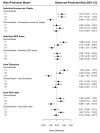Individual- and Area-Level SES in Diabetes Risk Prediction: The Multi-Ethnic Study of Atherosclerosis
- PMID: 28625713
- PMCID: PMC5584566
- DOI: 10.1016/j.amepre.2017.04.019
Individual- and Area-Level SES in Diabetes Risk Prediction: The Multi-Ethnic Study of Atherosclerosis
Abstract
Introduction: The purpose of this study was to evaluate if adding SES to risk prediction models based upon traditional risk factors improves the prediction of diabetes.
Methods: Risk prediction models without and with individual- and area-level SES predictors were compared using the prospective Multi-Ethnic Study of Atherosclerosis. Cox proportional hazards models were utilized to estimate hazard ratios for SES predictors and to generate 10-year predicted risks for 5,021 individuals without diabetes at baseline followed from 2000 to 2012. C-statistics were used to compare model discrimination, and the proportion of individuals reclassified into higher or lower risk categories with the addition of SES predictors was calculated. The accuracy of risk prediction by SES was assessed by comparing observed and predicted risks across tertiles of the SES variables. Statistical analyses were performed in 2015-2016.
Results: Over a median of 9.2 years of follow-up, 615 individuals developed diabetes. Individual- and area-level SES variables did not significantly improve model discrimination or reclassify substantial numbers of individuals across risk categories. Models without SES predictors generally underestimated risk for low-SES individuals or individuals residing in low-SES areas (underestimates ranging from 0.31% to 1.07%) and overestimated risk for high-SES individuals or individuals residing in high-SES areas (overestimates ranging from 0.70% to 1.30%), and the addition of SES variables largely mitigated these differences.
Conclusions: Standard diabetes risk models may underestimate risk for low-SES individuals and overestimate risk for those of high SES. Adding SES predictors helps correct this systematic misestimation, but may not improve model discrimination.
Copyright © 2017. Published by Elsevier Inc.
Figures


References
-
- Ali MK, Bullard KM, Saaddine JB, et al. Achievement of goals in U.S. diabetes care, 1999–2010. N Engl J Med. 2013;368(17):1613–1624. https://doi.org/10.1056/NEJMsa1213829. - DOI - PubMed
-
- Boyle JP, Thompson TJ, Gregg EW, et al. Projection of the year 2050 burden of diabetes in the U.S. adult population: dynamic modeling of incidence, mortality, and prediabetes prevalence. Popul Health Metr. 2010;8:29. https://doi.org/10.1186/1478-7954-8-29. - DOI - PMC - PubMed
-
- Seaquist ER. Addressing the burden of diabetes. JAMA. 2014;311(22):2267–2268. https://doi.org/10.1001/jama.2014.6451. - DOI - PubMed
-
- Noble D, Mathur R, Dent T, et al. Risk models and scores for type 2 diabetes: systematic review. BMJ. 2011;343:d7163. https://doi.org/10.1136/bmj.d7163. - DOI - PMC - PubMed
-
- Diabetes Prevention Program Research Group. Reduction in the Incidence of Type 2 Diabetes with Lifestyle Intervention or Metformin. N Engl J Med. 2002;346(6):393–403. https://doi.org/10.1056/NEJMoa012512. - DOI - PMC - PubMed
Publication types
MeSH terms
Grants and funding
- HHSN268201500003C/HL/NHLBI NIH HHS/United States
- N01 HC095161/HL/NHLBI NIH HHS/United States
- R01 HL071759/HL/NHLBI NIH HHS/United States
- UL1 RR024156/RR/NCRR NIH HHS/United States
- N01 HC095167/HL/NHLBI NIH HHS/United States
- N01 HC095159/HL/NHLBI NIH HHS/United States
- N01 HC095163/HL/NHLBI NIH HHS/United States
- HHSN268201500003I/HL/NHLBI NIH HHS/United States
- UL1 TR000040/TR/NCATS NIH HHS/United States
- N01 HC095166/HL/NHLBI NIH HHS/United States
- N01 HC095160/HL/NHLBI NIH HHS/United States
- UL1 RR025005/RR/NCRR NIH HHS/United States
- P30 DK092926/DK/NIDDK NIH HHS/United States
- UL1 TR001079/TR/NCATS NIH HHS/United States
- N01 HC095169/HL/NHLBI NIH HHS/United States
- N01 HC095162/HL/NHLBI NIH HHS/United States
- P30 DK092949/DK/NIDDK NIH HHS/United States
- N01 HC095165/HL/NHLBI NIH HHS/United States
- N01 HC095164/HL/NHLBI NIH HHS/United States
LinkOut - more resources
Full Text Sources
Other Literature Sources
Medical

